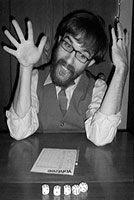
UnTwelve: Tell us what got you interested in alternative tunings and microtonality.
NC: The 'beginnings' would likely be playing guitar in middle/high school. I learned to play by ear - despite having studied violin since I was 5 - and I really liked tuning the guitar in open-tunings [I suppose this shows a preference for simple just-intonation systems!]. Running parallel during my 'axe-shredding' days was an interest in lutherie. From there, like many folks involved in microtonality, I found my way to Harry Partch and Genesis of a Music.
UnTwelve: What was the source of inspiration for your composition...did you have a preset goal in mind before you began?
NC: I began working on Homage to La Monte Young not as an homage, but as a performance piece for multiple electric guitars. The idea was to have an array of guitars tuned to the hum of the amplifiers. The performer would then manipulate the volume controls to entice feedback. As I rehearsed, it occurred to me that their was a precedent for this idea: Young's Composition 1960 #7 - B and F# "To be held for a long time." The amplifiers were of course 'humming' at 60Hz and its overtones. The homage is in a way an extension of Composition 1960 #7. Although, I make extensive use of the fifth partial (an interval that Young eschews).
UnTwelve: Can you elaborate more on the structure of the piece?
NC: A second source of inspiration comes from Robert Palmers' essay, "The Church of the Sonic Guitar." This particular passage is wonderful: "But an electric guitar, properly tuned to resonate with everything from the [concert] hall's acoustics to the underlying 60-cycle hum of the city's electrical grid, is forming its massive sound textures from harmonic relationships that already exist in nature; compare this to the arbitrary 'equal temperament' system which causes decidedly unharmonious harmonic interference patterns and dissonances when certain tones are allowed to ring together."
The organization of frequency content (pitch/harmony/timbre) of the homage is both an expansion of Young's piece and a realization of Palmer’s imagined music. The piece begins with only the 60-cycle hum of the amplifier (60 Hz = ca. B). ‘B’ and its overtones are introduced as the scordatura guitars and amplifiers enter into feedback loops. Slowly ‘F#’ and its partials materialize. After a series of crests and troughs, bowed and plucked sounds (from a homemade zither playing harmonics up to the 15th partial) are introduced along with the accelerating pulse of the amplifier’s tremolo. In the approach to the final climax a very low ‘E’ (20 Hz) and its partials emerge. The significance of the arrival of ‘E’ is three-fold: 1) ‘E’ balances the initial B-F# sonority, creating stacked 5th structure with ‘B’ at the center; 2) it coincides with the apex of the accelerating amplifier tremolo which approaches the auditory threshold; 3) ‘E’ is unmistakably the guitar chord, and the arrival marks a return to the guitar’s ‘correct’ tuning.
UnTwelve: Where does this work fit in to the rest of your output as a composer?
NC: That is a difficult question, as HLMY is really my first serious venture into microtonality. In other ways, however, it displays certain gestures that I tend to favor - the slowness with which it develops, the limitations on musical materials, and the wavering between noisy and pure tones.
UnTwelve: Who are some other influences of yours besides La Monte Young? Any composers past or present that stand out as sources of inspiration for you?
NC: Alvin Lucier is a huge influence. I very much admire the way his music seeks out the essence of an idea (compositionally speaking) and encourages everyone to listen more intently. I try to translate that into more "composerly" activity. Also, Ligeti - I always come back to Ligeti.
UnTwelve: Creatively speaking, are you pre-occupied with any exciting concepts lately?
NC: It being the start of summer and I've just finished a master's degree, I'm in need of a little fun. So, I've been getting into hardware hacking and such. I'm working my way through the projects in Nicolas Collins "Handmade Electronic Music." We'll see where it leads...
UnTwelve: Nicholas, any interesting projects around the corner for you?
NC: I'm very excited about a commission from a good friend of mine - Sean Gill - to write a piece for vibraphone and electronics. I'm playing with the idea of amplitude vs. frequency based beats. The vibraphone's motor provides the familiar tremolo and I'm working with detuning the electronics to produce beats with the live instrument. After that I'm going to take on a saxophone quartet!